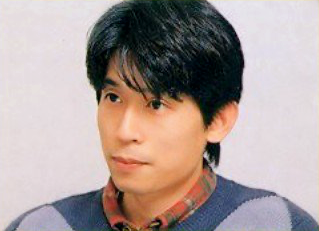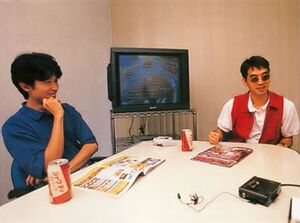Satoshi Mifune
From Sega Retro

|
| Satoshi Mifune |
|---|
| Date of birth: 1967-02-14[1] (age 57) |
| Employment history: Sega Enterprises (1985-04-01[1] – )
Divisions:
Divisions:
|
| Role(s): Programmer, Producer |
This teeny-tiny article needs some work. You can help us by expanding it.
Satoshi Mifune (三船 敏), also known by the alias Bin, is a Japanese businessman and former Sega of Japan programmer and producer. He has been cited as one of the earliest members of Sega AM2[3], closely following Yu Suzuki. His representative works include the Virtua Striker series, Virtua NBA, GP Rider, Turbo OutRun, Dynamite Dux, among others.
Contents
Career
Programming with Yu Suzuki
Satoshi Mifune began his career at Sega in 1985. While he had studied programming, video games were not on his radar, so did not seek out a job at Sega[4]. Rather, when he began job-hunting, an advertisement that Sega was recruiting was posted at his school, which he acted upon and was successfully employed[4]. He was initially assigned to the tabletop development department, but during the busy development of Hang-On, his programming expertise was called upon to aid developer Yu Suzuki[5][4]. Because of his instrumental support, he was reassigned to the same department as Suzuki (which later became Studio 128, Sega R&D 8 and Sega AM2), going on to program the Taikan games Space Harrier, OutRun and After Burner[5]. His first game as main programmer was Dynamite Dux, where his alias Bin also served as the namesake of the protagonist Bin, and he then became a game designer for Turbo OutRun. He was asked to make an OutRun game which was totally different from the original, turning it into more of a "racing game" than a "driving game"[6]. During the first month of the game's 4-month development cycle, Mifune was its only developer, while everyone else busy wrapping up development for Power Drift[6].
While he had worked closely with Suzuki up to this point, the two found themselves disagreeing on the design for GP Rider. Yu Suzuki stepped away from the project and gave Mifune free reign, and to prove his design was worthwhile, Mifune worked tirelessly to make GP Rider a success. Its sold surprisingly well[5][4] and he was praised for his talents designing racing games, and thus was greenlit to create F1 Exhaust Note, fulfilling one of his dream games upon joining Sega: an F1 game and football game[5]. Ambitions were bigger for its sequel, F1 Super Lap, which teamed up with Fuji Television to incorporate real-world F1 cars. However, the project was less successful, with Mifune citing the boom in 3D polygonal games as a major factor in the game not capturing F! realistically[4].
Director of Virtua Striker
File:SSM JP 19950401 1995-04.pdf His first 3D game followed F1 Super Lap, and it was Virtua Striker. Having been part of the football both in school and at Sega[7], Mifune was asked by Yu Suzuki to create a soccer game that could sell well in Europe, but Mifune put it off because he saw it as just a hobby. However, with vehicle-based games oversaturating the market, he felt the time was right to try something new. He felt pressured by the high expectations Yu Suzuki would likely have, and believed that, after The J.League 1994, the Tecmo World Cup series and Konami's Premier Soccer, everything had already been done. He was also struggling to work with the Model 1 board's capabilities and render 22 players on scree together. After extensive testing, he innovated the game by better promoting the game as a 2-player experience, thereby doubling potential profits, and switched to the more powerful Model 2, and was able to counter the sales department's concerns about the game with a successful location test[4].
Mifune did not remain at AM2 forever. In 1998, the new department Sega AM11 was spun out of it, and Mifune, alongside Toshihiro Nagoshi, became its most prominent employees, and were accompanied by their closest co-workers. Therefore, Mifune and his Virtua Striker team ended up at this department, followed by Sega Software R&D Dept. 4 and Amusement Vision. However, Sega made the decision in 2003 to restructure its subsidiaries, swapping various developers between Amusement Vision and Smilebit which would re-establish Smilebit as a sports-only developer. Mifune transferred to this developer, remaining with it as it became Sega Sports Design R&D Dept.[2], not only continuing the Virtua Striker series, but also helping with the Let's Make Soccer franchise[4].
After leaving Sega around 2009[4], he joined studio fake, a company founded by former AM2 colleague Keiji Okayasu.[8]
Production history
Games
- Hang-On (Hang-On hardware; 1985) — Programing Support
- Space Harrier (Hang-On hardware; 1985) — Programming
- OutRun (OutRun hardware; 1986) — Programming (as BIN)
- Space Harrier (Master System; 1986) — Special Thanks (as Bin Chan)
- After Burner (X Board; 1987) — Programmer
- After Burner (X Board; 1987) (as Bin)
- After Burner II (X Board; 1987) — Programmer
- After Burner II (X Board; 1987) (as Bin)
- Dynamite Dux (System 16; 1988) — Main Program[9] (as bin_chan_san)
- Turbo OutRun (OutRun hardware; 1989) — Game Design (as Bin)
- Turbo OutRun (OutRun hardware; 1989) — Program (as Bin)
- Sword of Vermilion (Mega Drive; 1989) — Program (as Bin)
- Sword of Vermilion (Mega Drive; 1989) — Special Thanks (as Bin)
- GP Rider (X Board; 1990) (as Bin)
- Rent A Hero (Mega Drive; 1991) — Super Visor[10] (as Bin)
- F1 Exhaust Note (System 32; 1991)
- Virtua Striker (Model 2; 1995) — Programmer
- Virtua Striker (Model 2; 1995) — Planner
- Virtua Striker (Model 2; 1995) — Producer
- Virtua Striker (Model 2; 1995) — FW
- Virtua Cop 2 (Model 2; 1995) — Special Thanks
- Virtua Striker 2 (Model 3; 1997) — Producer & Game Director
- Virtua Striker 2 Version '98 (Model 3; 1998) — programmers
- Virtua Striker 2 Version '98 (Model 3; 1998) — producer & game director
- Virtua Striker 2 Version '99 (Model 3; 1998) — programmers
- Virtua Striker 2 Version '99 (Model 3; 1998) — producer & game director
- Virtua Striker 2 Ver. 2000 (NAOMI; 1999) — programers
- Virtua Striker 2 Ver. 2000 (NAOMI; 1999) — producer & game director
- Virtua Striker 2 Ver. 2000.1 (Dreamcast; 1999) — programmers
- Virtua Striker 2 Ver. 2000.1 (Dreamcast; 1999) — producer & game director
- Shenmue (Dreamcast; 1999) — System Programmers
- Virtua NBA (NAOMI; 2000) — Producer
- Virtua Striker 3 (NAOMI 2; 2001) — producer & game director
- US Shenmue (Dreamcast; 2001) — System Programers
- Virtua Striker 3 Ver. 2002 (Triforce; 2002) — Producer & game director
- Virtua Striker 3 Ver. 2002 (GameCube; 2002) — Producer & game director
- Virtua Striker 4 (Triforce; 2004) — Producer & Director
- Pro Yakyuu Team o Tsukurou! 3 (PlayStation 2; 2005) — Special Thanks (as 三舩 敏)
- Virtua Striker 4 Ver. 2006 (Triforce; 2006) — Producer & Director
- Let's Make a Soccer Team! (PlayStation 2; 2006) — Special Thanks
- Virtua Pro Football (PlayStation 2; 2006) — Special Thanks
Videos
- Out Run/Turbo Out Run Strategy Movie & S.S.T. Band Live+1 (DVD; 2007) — Special Thanks
Music
- Virtua Striker & Virtua Striker 2 (CD; 1997) — Producer&Director
- Virtua Striker & Virtua Striker 2 (CD; 1997) — Main Programmer
- OutRun 20th Anniversary Box (CD; 2007) — Commentator
Magazine articles
- Main article: Satoshi Mifune/Magazine articles.
Interviews
Photographs
- Main article: Photos of Satoshi Mifune
External links
- Video Game Storytellers Part 5: The Journey of Satoshi Mifune and Hiroyuki Nakagomi, the Creators of Virtua Striker article by Fumio Kurokawa at 4Gamer.net (Japanese)
References
- ↑ 1.0 1.1 http://www.sega.co.jp/AM2/news/0117.html (Wayback Machine: 1997-02-15 16:10)
- ↑ 2.0 2.1 http://sega.jp/segamoba/about/column.html (Wayback Machine: 2009-12-19 12:39)
- ↑ Sega Saturn Magazine, "April 1995" (JP; 1995-03-08), page 118
- ↑ 4.0 4.1 4.2 4.3 4.4 4.5 4.6 4.7 https://www.4gamer.net/games/999/G999905/20180418132/ (Wayback Machine: 2023-11-30 00:25)
- ↑ 5.0 5.1 5.2 5.3 Sega Saturn Magazine, "June 1995" (JP; 1995-05-08), page 118
- ↑ 6.0 6.1 OutRun 20th Anniversary Box
- ↑ Interview: Satoshi Mifune (2002-02-06) by Sega.jp
- ↑ http://www.studiofake.co.jp/company_enkaku.html
- ↑ File:DynamiteDux arcade credits.pdf
- ↑ File:Rent A Hero MD credits.pdf
- Sega Enterprises, Ltd. employees
- Sega R&D 1 staff members
- Studio 128 staff members
- Sega R&D 8 staff members
- Sega AM2 staff members
- Sega AM11 staff members
- Sega Software R&D Dept. 4 staff members
- Amusement Vision employees
- Sega Corporation (2000-2015) employees
- Sega Sports Design R&D Dept. staff members
- Programmers
- Producers
- All people
- Sub-stubs
